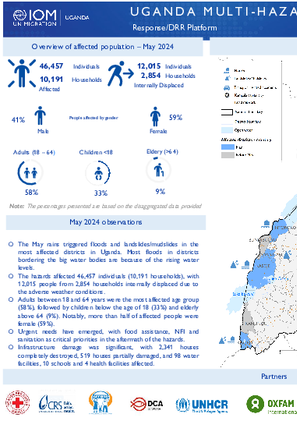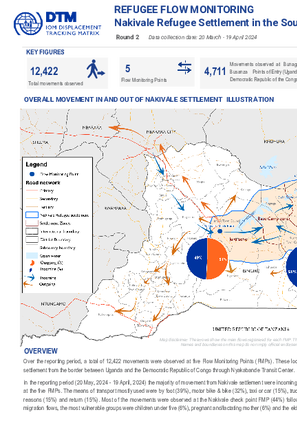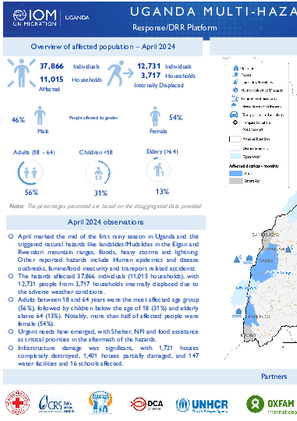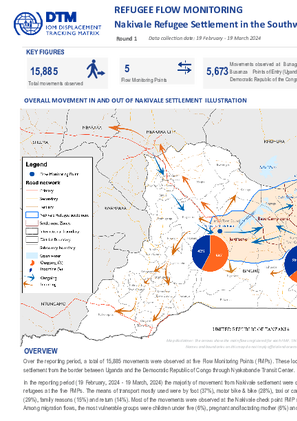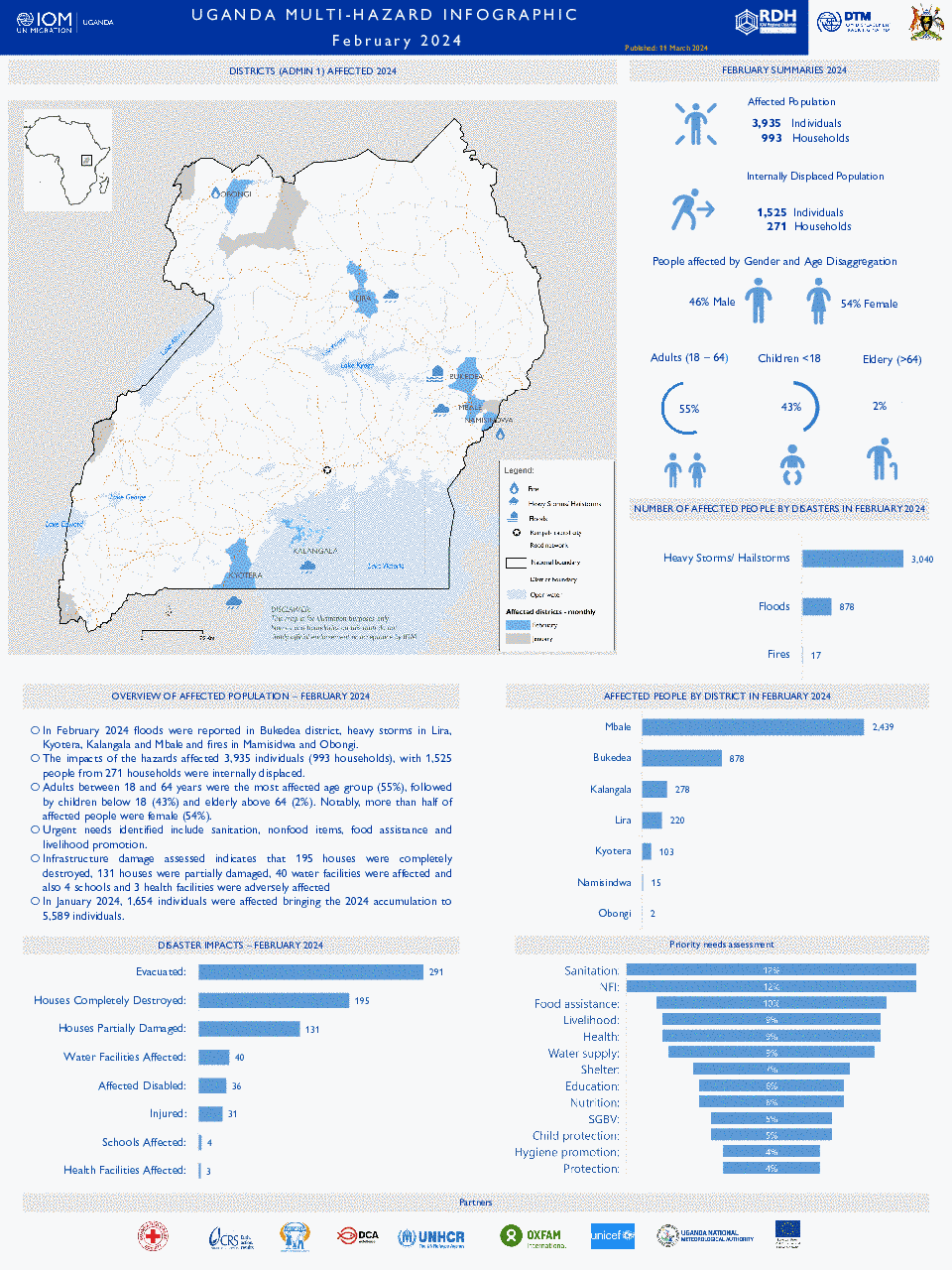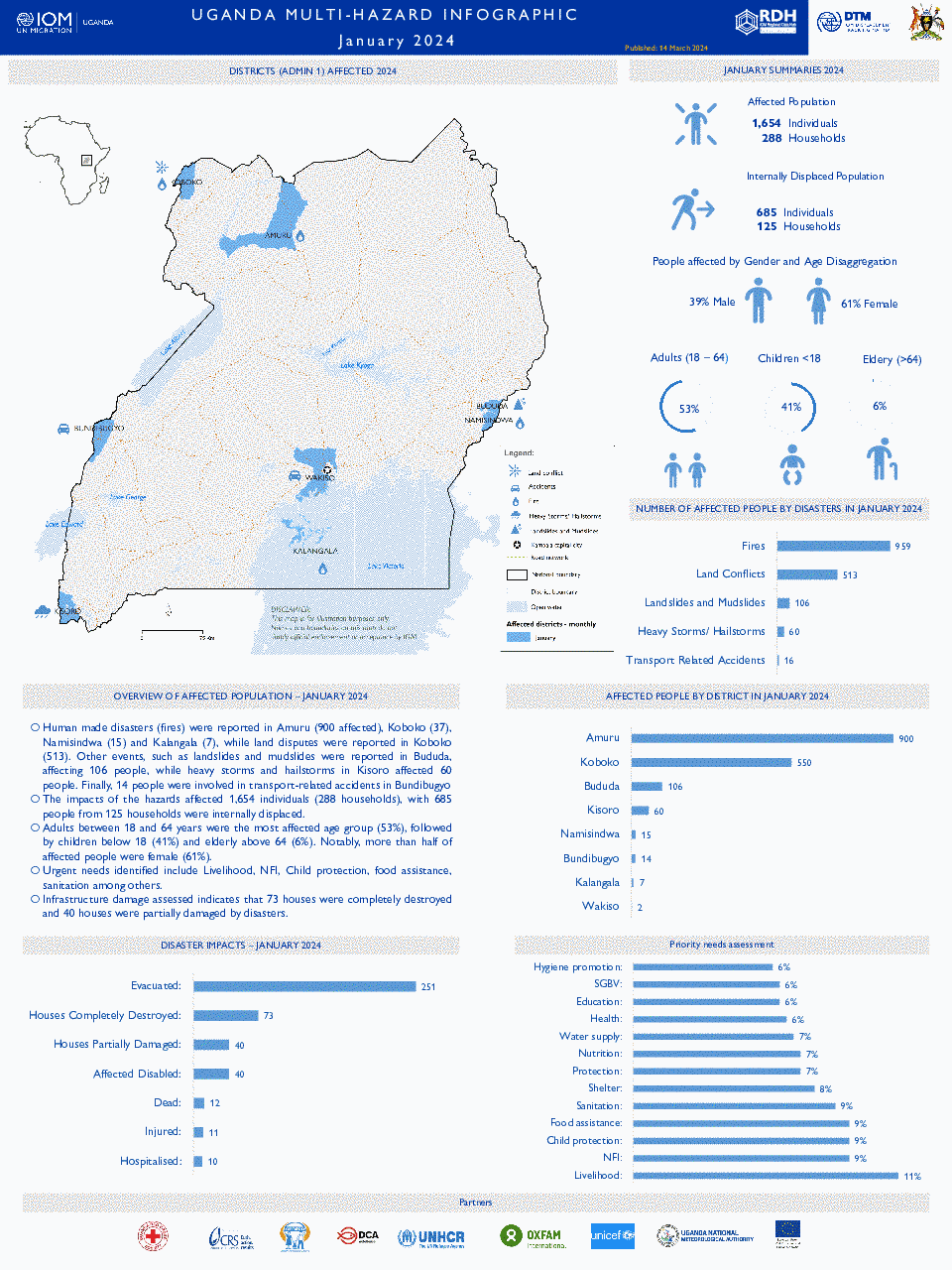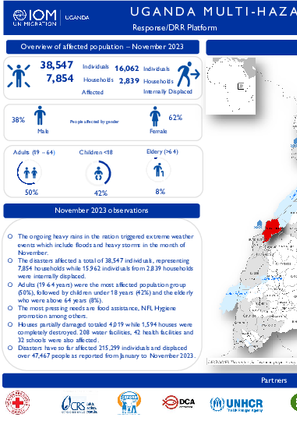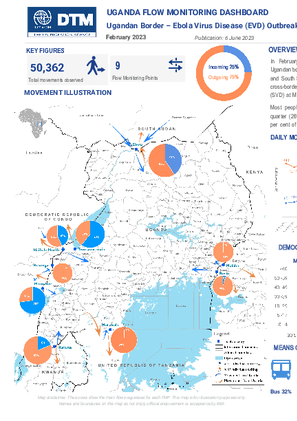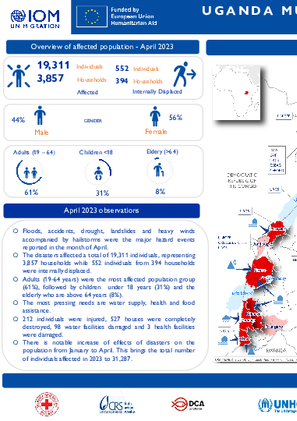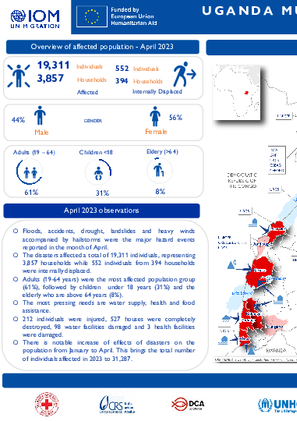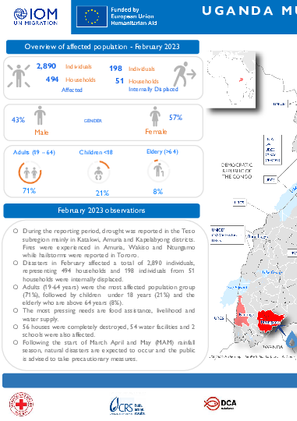-
Countries
-
Data and Analysis
-
Special Focus
-
Crisis Responses
Uganda
Uganda
IDPs tracked
Displacement Movements
4,800
IDMC 2023
Data collection round
About Uganda
In view of the political and conflict situation in neighboring countries of South Sudan and the Democratic Republic of Congo (DRC), there has been an increasing number of people moving into Uganda. In response to the need for timely and accurate information on the movements and needs of the displaced population, the International Organization for Migration (IOM) in Uganda began implementing the Displacement Tracking Matrix (DTM) in March 2018. The DTM activities conducted in Uganda include Flow Monitoring Registry (FMR) and Flow Monitoring Surveys (FMS), which aim at providing disaggregated data on the movements volume and trends as well as qualitative information on individuals’ educational and vocational backgrounds of travelers, their intended destinations, the routes taken, and the challenges faced along the way. IOM Uganda is currently monitoring population flows at twenty-one points of entry (POE), fifteen on the Ugandan border with DRC and six along the border with South Sudan. The data collected is shared with relevant governmental stakeholders and other humanitarian partners to develop adequate interventions and provide the necessary assistance.
Contact
DTM Uganda
dtmuganda@iom.int
Current Donors
- European Union
Uganda — Info Sheet: Multi-Hazard Response/DRR Platform (May 2024)
The May rains triggered floods and landslides/mudslides in the most affected districts in Uganda. Most floods in districts bordering the big water bodies are because of the rising water levels.
UGANDA: REFUGEE FLOW MONITORING - Nakivale Refugee Settlement in the Southwest Region of Uganda (20 March - 19 April 2024)
Over the reporting period, a total of 12,422 movements were observed at five Flow Monitoring Points (FMPs).
Uganda – Info Sheet: Multi-Hazard Response/DRR Platform (April 2024)
April marked the mid of the first rainy season in Uganda and this triggered natural hazards like landslides/Mudslides in the Elgon and Rwenzori mountain ranges, floods, heavy storms and lightning.
UGANDA: REFUGEE FLOW MONITORING - Nakivale Refugee Settlement in the Southwest Region of Uganda (19 February - 19 March)
Over the reporting period, a total of 15,885 movements were observed at five Flow Monitoring Points (FMPs) through random interviews with travelers.
Uganda - Info Sheet: Multi-Hazard Response/DRR Platform (March 2024)
In March there were reports of affected people due to Heavy Storms or Hailstorms in the districts of Kanungu (8,620), Namisindwa (825), Bunyangabu (580), Buikwe (262), Mubende (40) and Wakiso (25).
Uganda - Info Sheet: Multi-Hazard Response/DRR Platform (February 2024)
In February 2024, floods were reported in the Bukedea district, heavy storms in Lira, Kyotera, Kalangala and Mbale and fires in Mamisidwa and Obongi. The impacts of the hazards affected 3,935 individuals (993 households) with 1,525 people from 271 households were internally displ
Uganda - Info Sheet: Multi-Hazard Response/DRR Platform (January 2024)
Human made disasters (fires), land disputes and extreme weather events such as landslides, mudslides as well as heavy storms and hailstorms have led to significant devastation in the districts of Amuru, Koboko, Bududa, Kisoro, Namisindwa, Bundibugyo, Kalangala and Wakiso.
Uganda - Info Sheet: Multi-Hazard Response/DRR Platform (December 2023)
As the September to December (SOND) rainfall season winds down, extreme weather events, specifically floods, landslides, hailstorms, and heavy winds have led to significant devastation in the affected districts.
Uganda - Emergency Event Tracking (EET) - EL Niño Impacts (1 October - 14 November 2023)
In September 2023, the Prime Minister Office’s, in conjunction with Ministry of Water & Environment and Uganda National Meteorological Authority published an alert on the potential impacts of floods related to el niño during the September – December rainy season.
Uganda – Info Sheet: Multi-Hazard Response/DRR Platform (November 2023)
The ongoing heavy rains in the nation triggered extreme weather events which include floods and heavy storms in the month of November.
Uganda – Info Sheet: Multi-Hazard Response/DRR Platform (September 2023)
The month of September marked the beginning of the SOND rainfall season and also the beginning of the El-Nino impact as forecasted by UNMA. These climatic events triggered heavy storms/Hailstorms in the different parts of the nation, floods and landslides/Mudslides.
Uganda – Info Sheet: Multi-Hazard Response/DRR Platform (August 2023)
Disasters have so far affected 95,170 individuals and displaced over 7,662 people as reported from January to August 2023.
Uganda – Info Sheet: Multi-Hazard Response/DRR Platform (July 2023)
In the month of July 2023, floods were reported in Kapelebyong & Gulu, human epidemics outbreaks (Cholera) in Kayunga, Namayingo & Nakaseke (rift valley fever) and road accidents in Kagadi and Kampala.
Uganda – Info Sheet: Multi-Hazard Response/DRR Platform (June 2023)
There was a notable reduction on the impacts, extent and intensity of disaster in the month of June. Floods were reported in Kasese, Bukedea and Kapelabyong. Heavy storms occurred in Namisindwa and Manafwa while landslides in Bududa.
Uganda — Flow Monitoring Dashboard: Ebola Virus Disease Outbreak (February 2023)
In February 2023, 50,362 movements were tracked at nine Flow Monitoring Points (FMPs) at the Ugandan border with Kenya, the Democratic Republic of Congo, the United Republic of Tanzania, Rwanda and South Sudan.
Uganda — Flow Monitoring Dashboard: Ebola Virus Disease Outbreak (January 2023)
In January 2023, 58,629 movements were tracked at nine Flow Monitoring Points (FMPs) at the Ugandan border with Kenya, the Democratic Republic of Congo, the United Republic of Tanzania, Rwanda and South Sudan.
Uganda - Info Sheet: Multi-Hazard Response/DRR Platform (April 2023)
Floods, accidents, drought, landslides and heavy winds accompanied by hailstorms were the major hazard events reported in the month of April. The disasters affected a total of 19,311 individuals, representing 3,857 households while 552 individuals from 394 households were interna
Uganda – Info Sheet: Multi-Hazard Response/DRR Platform (4 May 2023)
Floods, accidents, drought, landslides and heavy winds accompanied by hailstorms were the major hazard events reported in the month of April. The disasters affected a total of 19,311 individuals, representing 3,857 households while 552 individuals from 394 households were internally displaced.
Uganda - Info Sheet: Multi-Hazard Response/DRR Platform (February 2023)
During the reporting period, drought was reported in the Teso subregion mainly in Katakwi, Amuria and Kapelabyong districts. Fires were experienced in Amuria, Wakiso and Ntungamo while hailstorms were reported in Tororo. Disasters in February affected a total of 2,890 i
Uganda – Info Sheet: Multi-Hazard Response/DRR Platform (16 March 2023)
During the reporting period, drought was reported in the Teso subregion mainly in Katakwi, Amuria and Kapelabyong districts. Fires were experienced in Amuria, Wakiso and Ntungamo while hailstorms were reported in Tororo.
Uganda — Flow Monitoring Dashboard: Ebola Virus Disease Outbreak (December 2022)
Over the reporting period, a total of 50,166 movements were observed at nine (9) Flow Monitoring Points (FMPs) at the Ugandan border with Kenya, the Democratic Republic of Congo, the United Republic of Tanzania, Rwanda and South Sudan.
Uganda – Info Sheet: Multi-Hazard Response/DRR Platform (January 2023)
In January 2023, three districts were reported to be hit by disasters. Floods were reported in Kampala while Kanungu was ravaged by heavy storms and wildfires in Kotido.
Uganda – Info Sheet: Multi-Hazard Response/DRR Platform (2022)
The year 2022, Uganda experienced multi-hazards events that include Natural disasters like drought, floods, landslides/mudslides and heavy storms/hailstorms. And in the month of September, the ministry of health declared the outbreak the Ebola Virus Disease in Uganda.
Uganda — Flow Monitoring Survey Dashboard: Uganda/Kenya Border (November 2022)
In November 2022, a total of 2,833 people were interviewed at four Flow Monitoring Points (FMPs) across the border between Uganda and Kenya. Similar to the previous period, more people interviewed were incoming into Uganda (52%) than outgoing to Kenya (48%).
Pagination
Uganda - Multi-Hazard Response/DRR Platform (April 2024)
2024-05-03
<p>In April 2024, the hazards affected <strong>37,866</strong> individuals (<strong>11,015</strong> households), with <strong>12,731</strong> people from <strong>3,717</strong> households internally displaced due to the adverse weather…
Uganda - Multi-Hazard Response/DRR Platform (March 2024)
2024-03-29
<p>In March, the impacts of the hazards affected <strong>10,390</strong> individuals (<strong>2,387</strong> households), with 426 people from 91 households were internally displaced. Children below the age of 18 were the most affected age group (67%), followed by…
Uganda - Multi-Hazard Response/DRR Platform (February 2024)
2024-02-29
<p>In February 2024, the impacts of the hazards affected <strong>3,935 </strong>individuals (<strong>993</strong> households), with <strong>1,525</strong> people from<strong> 271</strong> households were internally displaced.</p>
Uganda - Multi-Hazard Response/DRR Platform (January 2024)
2024-02-01
<p>In January, the impacts of the hazards affected <strong>1,654 </strong>individuals (<strong>288</strong> households), with <strong>685 </strong>people from <strong>125</strong> households were internally displaced.</p>
Uganda - Multi-Hazard Response/DRR Platform (December 2023)
2023-12-29
<p>As the September to December (SOND) rainfall season winds down, extreme weather events, specifically floods, landslides, hailstorms, and heavy winds have led to significant devastation in the affected districts. The disasters have adversely impacted <strong>7,052 individuals</…
Uganda - Multi-Hazard Response/DRR Platform (November 2023)
2023-11-30
<p>The ongoing heavy rains in the nation triggered extreme weather events which include floods and heavy storms in the month of November.</p><ul><li>The disasters affected a total of <strong>38,547 individuals</strong>, representing 7,854 households while 15,962…
Uganda - Emergency Event Tracking (EET) - EL Niño Impact Tracking (November 2023)
2023-11-14
<p>In September 2023, the Prime Minister Office’s, in conjunction with Ministry of Water &amp; Environment and Uganda National Meteorological Authority published an alert on the potential impacts of floods related to el niño during the September – December rainy season. To monitor those,…
Uganda - Multi-Hazard Response/DRR Platform (September 2023)
2023-09-30
In September, 2557 individuals and 662 households were affected. 246 individuals and 57 households were internally displaced.
Uganda - Multi-Hazard Response/DRR Platform (August 2023)
2023-08-31
In August 2023, 2904 individuals and 864 households were affected. 1041 individuals and 24 households were internally displaced.
Uganda - Multi-Hazard Response/DRR Platform (Jan-July 2023)
2023-07-31
From January to July 2023, 90,226 people were affected, and 2,401 people were displaced by multi-hazards in Uganda.
Uganda - Multi-Hazard Response/DRR Platform (July 2023)
2023-07-30
In the month of July 2023, floods were reported in Kapelebyong & Gulu, human epidemics outbreaks (Cholera) in Kayunga, Namayingo & Nakaseke (rift valley fever) and road accidents in Kagadi and Kampala. The disasters affected a total of 2,040 individuals, representing 300 households and…
Uganda - Multi-Hazard Response/DRR Platform (2022)
2022-12-31
This dataset shows the number of individuals and households affected and the impacts of disasters on a monthly basis at a district (Admin 2) level in Uganda. A total of 171,148 individuals were affected in 2022.
Uganda — Baseline Assessment — May 2020 — Round 1
2020-05-29
A baseline assessment is a sub-component of mobility tracking. It aims to collect data on IDP, migrant or returnee population presence in a defined administrative area of the country.
Uganda- Flow monitoring (22 Dec 2018 - 05 Jan 2019)
2019-01-05
Flow monitoring aims to derive quantitative estimates of the flow of individuals through specific locations and to collect information about the profile, intentions and needs of the people moving and to quantify highly mobile populations by providing a picture of complex mobility dynamics.
Uganda- Flow monitoring (07 - 21 December 2018)
2018-12-21
Flow monitoring aims to derive quantitative estimates of the flow of individuals through specific locations and to collect information about the profile, intentions and needs of the people moving and to quantify highly mobile populations by providing a picture of complex mobility dynamics.
Uganda- Flow monitoring (16 - 30 November 2018)
2018-11-30
Flow monitoring aims to derive quantitative estimates of the flow of individuals through specific locations and to collect information about the profile, intentions and needs of the people moving and to quantify highly mobile populations by providing a picture of complex mobility dynamics.
Uganda - Flow Monitoring (April 2018 - December 2019)
Multiple maps illustrating all outgoing and incoming movements from Uganda tracked by the Displacement Tracking Matrix’s Flow Monitoring project. The maps are comprised of data from different periods, with the earliest from April 2018.


